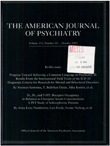Dissociative reactions to the San Francisco Bay Area earthquake of 1989
Abstract
OBJECTIVE: This study systematically evaluated the psychological reactions of a nonclinical population to the October 1989 earthquake in the San Francisco Bay Area. METHOD: A representative group of about 100 graduate students from two different institutions in the Bay Area volunteered to participate in the study. Within 1 week of the earthquake, the authors administered a checklist of anxiety and dissociative symptoms to the subjects, and 4 months later they conducted a follow-up study with the same checklist. RESULTS: The participants reported significantly greater numbers and frequency of dissociative symptoms, including derealization and depersonalization, distortions of time, and alterations in cognition, memory and somatic sensations, during or shortly after the earthquake than after 4 months. To a lesser degree they also reported significantly more nonsomatic anxiety symptoms and Schneider's first-rank symptoms at the earlier testing time. CONCLUSIONS: These results suggest that among nonclinical populations, extreme distress may significantly increase the prevalence and severity of transient dissociative phenomena and anxiety. They provide further evidence of the role that dissociation plays in the response to trauma and are of considerable clinical and theoretical importance in view of the lifetime prevalence of traumatic experiences in the general population.
Access content
To read the fulltext, please use one of the options below to sign in or purchase access.- Personal login
- Institutional Login
- Sign in via OpenAthens
- Register for access
-
Please login/register if you wish to pair your device and check access availability.
Not a subscriber?
PsychiatryOnline subscription options offer access to the DSM-5 library, books, journals, CME, and patient resources. This all-in-one virtual library provides psychiatrists and mental health professionals with key resources for diagnosis, treatment, research, and professional development.
Need more help? PsychiatryOnline Customer Service may be reached by emailing [email protected] or by calling 800-368-5777 (in the U.S.) or 703-907-7322 (outside the U.S.).



